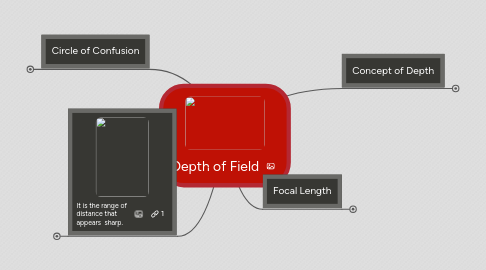
1. Circle of Confusion
1.1. It defines how much a point needs to be blurred in order to be perceived as unsharp.
1.1.1. An acceptably sharp circle of confusion is loosely defined as one which would go unnoticed when enlarged to a standard 8x10 inch print, and observed from a standard viewing distance of about 1 foot.
1.1.1.1. At this viewing distance and print size, camera manufacturers assume a circle of confusion is negligible if no larger than 0.01 inches (when enlarged). As a result, camera manufacturers use the 0.01 inch standard when providing lens depth of field markers (shown below for f/22 on a 50mm lens). The circle of confusion has to be even smaller than this to achieve acceptable sharpness throughout.
1.2. Bokeh
1.2.1. Note that depth of field only sets a maximum value for the circle of confusion, and does not describe what happens to regions once they become out of focus. These regions also called "bokeh," from Japanese (pronounced bo-ké). Two images with identical depth of field may have significantly different bokeh, as this depends on the shape of the lens diaphragm.
2. It is the range of distance that appears sharp.
2.1. The depth of field gradually transitions from sharp to unsharp.
3. Concept of Depth
3.1. It's also called, the "focus spread."
3.2. It differs from depth of field in that it describes the distance over which light is focused at the camera's sensor, as opposed to the subject.
3.3. When an object is in focus, light rays originating from that point converge at a point on the camera's sensor. If the light rays hit the sensor at slightly different locations (arriving at a disc instead of a point), then this object will be rendered as out of focus — and increasingly so depending on how far apart the light rays are.
4. Focal Length
4.1. Even though telephoto lenses appear to create a much shallower depth of field, this is mainly because they are often used to magnify the subject when one is unable to get closer.
4.2. If the subject occupies the same fraction of the image (constant magnification) for both a telephoto and a wide angle lens, the total depth of field is virtually constant with focal length. This would of course requires one to either get much closer with a wide angle lens or much further with a telephoto lens.
4.3. Chart
4.3.1. Focal Length (mm)
4.3.1.1. 10 20 50 100 200 400
4.3.2. Focus Distance (m)
4.3.2.1. 0.5 1.0 2.5 5.0 10 20
4.3.3. Depth of Field (m)
4.3.3.1. 0.482 0.421 0.406 0.404 0.404 0.404
